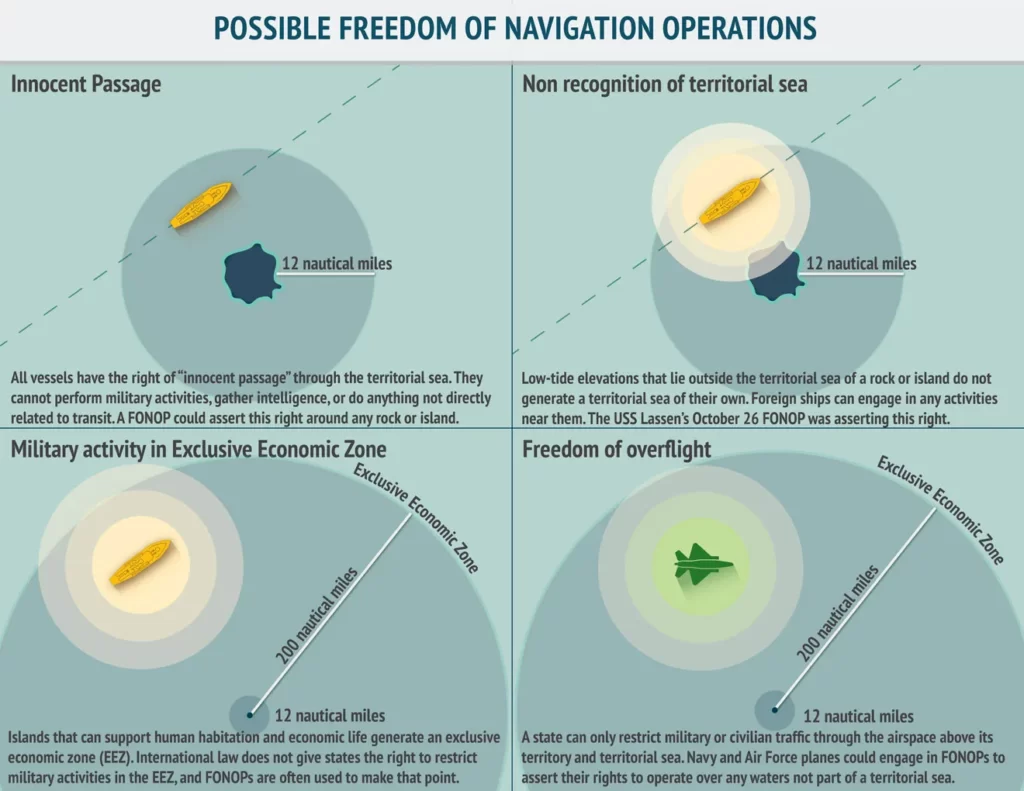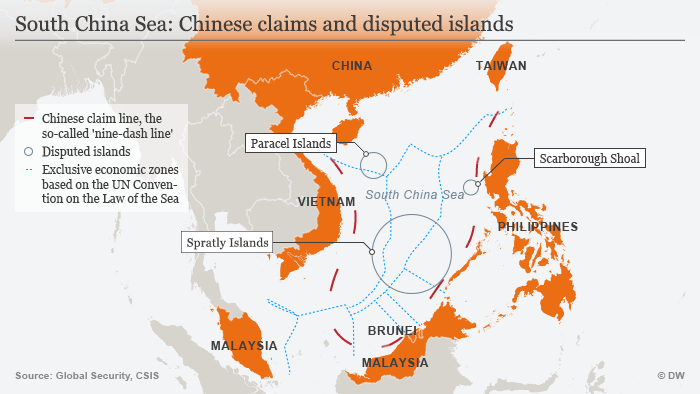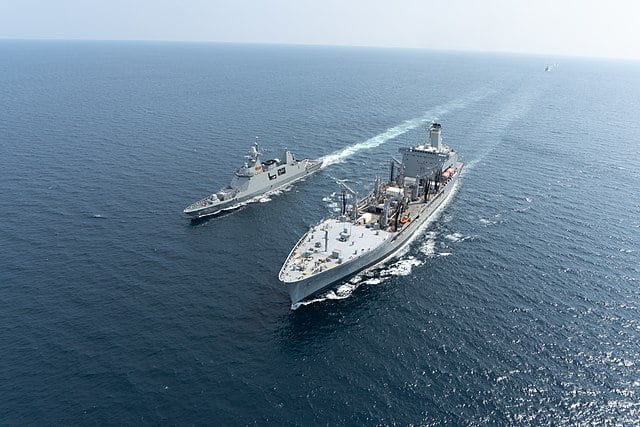Over the past few years, the South China sea (SCS) has developed as an arena for US-China strategic rivalry. The sea has become an important channel for trade and broader security of a region that is growing in its economic and strategic importance. Besides trade, it is also used for fishing purposes and to obtain oil resources on a large scale. China claims the South China Sea is under its control by specifying the nine-dashed line around the sea on its official maps of Chinese territory. However, the five neighbouring countries include Brunei, Malaysia, Philippines, Vietnam, and Taiwan, also claims ownership of the sea.

Furthermore, China’s maritime actions in the East China Sea (ECS) also threatened the US and its allies. Its domination of SCS and ECS, along with the Yellow Sea, would considerably affect US strategic, political, and economic interests in the Indo-Pacific region. According to the United States, these illegal expansion activities from China gaining complete control over the South China Sea violate international maritime law. Thus, the US is engaging its resistance in conducting extensive maritime claims in various parts of the world through the United State Freedom of Navigation Program (FONOP). This program is being conducted widely by the US and its allies in the SCS, mainly aimed at Chinese illegal maritime claims in the region.
It remains to be comprehended how far the US freedom of navigation operations are restraining Chinese expansionist activities in the SCS.
What Is FONOPs?
FONOPs, Freedom of Navigation Operations, is a method closely linked to the concept of freedom of navigation and specific to the execution of relevant international law and customs regarding the freedom of navigation. It is a method of enforcing the United Nations Convention on the Law of the Sea (UNCLOS) by avoiding adverse outcomes by highlighting the freedom of navigation through practice. FONOPs encompasses passages directed by the US navy in the exclusive waters of coastal nations.

Image courtesy-Asia Maritime Transparency Initiative
Its purpose is that this operation symbolizes that the United States did not agree to the exclusive maritime claims of the coastal nations, thus preventing those claims from becoming conventional in international law. Being in operation for almost 40 years, this program has continuously reiterated the US policy of exercising firm navigation and freedom rights worldwide.
Importance of South China Sea
The South China Sea covers the southern tip of China and includes an area through which 40% of the whole world’s trade permits. It contains the Strait of Malacca, a significant channel to import oils into this region. Since around 2009, China has strengthened its maritime territorial claims in the South China Sea and tried to prevent other states from establishing their claims at China’s expense. It also implemented a set of diplomatic, administrative, economic, and military strategies to widen its effective control over the disputed territories.
China’s actions in the SCS include extensive island building, base construction activities, and building its military bases on a large scale. The USA and its regional allies strongly oppose these highly sensitive issues conducted by China in the SCS.
China’s Expansion in the SCS and ECS?
For five decades, China has been continuously operating in the part of SCS to increase its control over this region. The movement as part of this expansion has accelerated since 2010. From the 1970s to the 1980s, China took control over the Paracel Islands in the quadrant of the SCS and Johnson South Reef in the Spratly Islands in the southeast quadrants of the SCS. Both islands were exclusive economic zone (EEZ) of Vietnam

Image courtesy-The Guardian
In 2009, China came up with a more well-developed strategy. It affirmed its Nine-Dash line claim partly in response to a deal between Vietnam and Malaysia that divided their EEZs and continental shelves. From 2013-2018, Beijing carried out major island-building projects on seven outposts. It also formed military bases on them, refining the Chinese strategic position by inducting missiles, building runways, and boosting its A2/AD capabilities. Thus China continued to pressure on other Philippine and Vietnamese outposts in the Spratly Islands.
China’s Maritime Territorial Disputes
China is a party to multiple maritime territorial disputes in South China and the East China Sea. The four most important disputes that thoroughly avoid the claims emerging from the neighbouring states are listed below.
- A major dispute over the Paracel Islands in the SCS, which both China and Vietnam claim.
- Dispute over the Spratly Islands in the SCS, which is claimed entirely by China, Taiwan, and Vietnam.
- The dispute over Scarborough Shoal in the SCS is claimed by China, Taiwan, and the Philippines. China has controlled it since 2012.
- The dispute over the Senkaku Islands in the ECS, which China, Taiwan, and Japan claim. It is now under the control of Japan, but China is trying to expand its influence over this island.

China is using its strategic expansionist tendency toward the South China Sea to become a unilateral power in the world against all superpowers. Thus, the US and its regional allies are building massive interventions in the Indo-Pacific region against China’s policy.
The Efficiency of the FONOPs in the South China Sea
The Obama administration shipped a P8-A Poseidon surveillance plane, taking CNN news reporters to fly over the China-controlled Fiery Cross Reef in the Spratly waters in the South China Sea in May 2015. The Chinese government warned them to go back from the alert zone, while the US replied that they had done a lawful operation over international water. This was the first time the US government took the initiative to expose the FONOP and military encounter with the South China Sea.

Image courtesy-CNN
The US has steered more FONOPs towards China from mid-2015 up until 2019 in the South China Sea. Between 2015 to 2016, the Obama administration conducted five operations challenging certain China-controlled land features in the Spratly and the Paracel waters. Under Trump Administration, the number has increased crucially and has done four such operations in 2017, five in 2018, and eight in 2019. Under Trump’s administration, China was considered a “strategic competitor, ” and the SCS has appeared as an arena for competition. Thus, the program became vital, including the efforts to form a “free and open Indo-Pacific Region”.
With the Biden Administration, the US is an active counterbalance to China’s growing dominance in the Indo-Pacific region. During his presidency, the US has made two such operations, the USS Curtis Wilbur sailed through the tension-filled Taiwan strait, and Curtis Wilbur entered the waters near another contested territory in the SCS called the Paracel Islands.

How Do Other Nations See US FONOPs?
Numerous regional countries have considered the US FONOPs essential for maintaining rules-based international order and freedom of navigation in the South China Sea. These nations consider FONOPs essential to contain China’s expansive territorial and maritime claims. For instance, countries like the Philippines and Vietnam which got intertwined in disputes with China, continue to feel threatened by China’s assertive behaviours. US allies and partners such as the UK, Japan, Australia, New Zealand, France, Canada, and India (both individually and jointly) have also followed their versions of freedom of navigation.

Image courtesy-Asia Times
However, from a political standpoint, the US is trying to reassure allies and partners of its commitment to maintaining security and order in the region through FONOPs in the disputed areas in the SCS and ECS.
Conclusion
Recently, the US position on the China-Taiwan, including the US House of Representatives Speaker Nanci Pelosi’s visit to Taiwan, has triggered China. In light of all these events, the FONOP operations by the United States and allied nations against China’s expansionist activities in the South China Sea could prevent China from achieving its full objectives and aims in the SCS. Apparently, the US fears that China’s strategic activities in the South China Sea could turn China into the biggest power in the world. The West, at any cost, will try to stop this.
You may also be interested in:
How the Bush Doctrine Contributed to the Failure of the US Military Campaign in Afghanistan?
About the Author

Apart from being a talented football player and a hodophile, Unais is also an active social worker in Kerala. He is pursuing his master’s degree from Mahatma Gandhi University, Kottayam, in International Relations and Politics. From his political science background, he has a keen interest in areas like Migration and Refugee Studies, Gender Studies and World Politics.







[…] Effectiveness of FONOPs in Preventing Chinese Expansionism […]